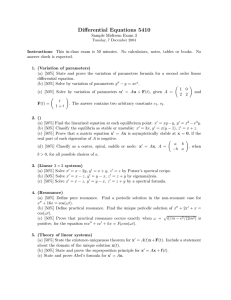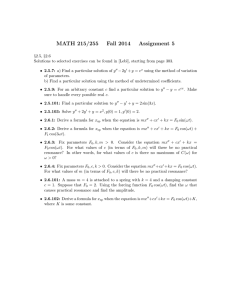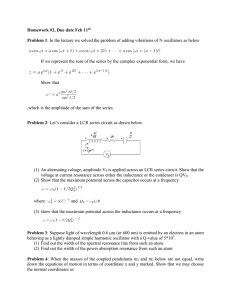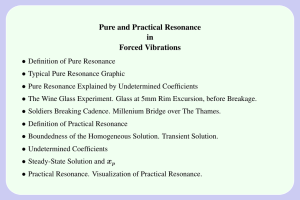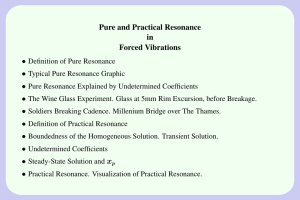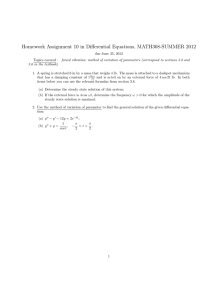Pure and Practical Resonance in Forced Vibrations •
advertisement
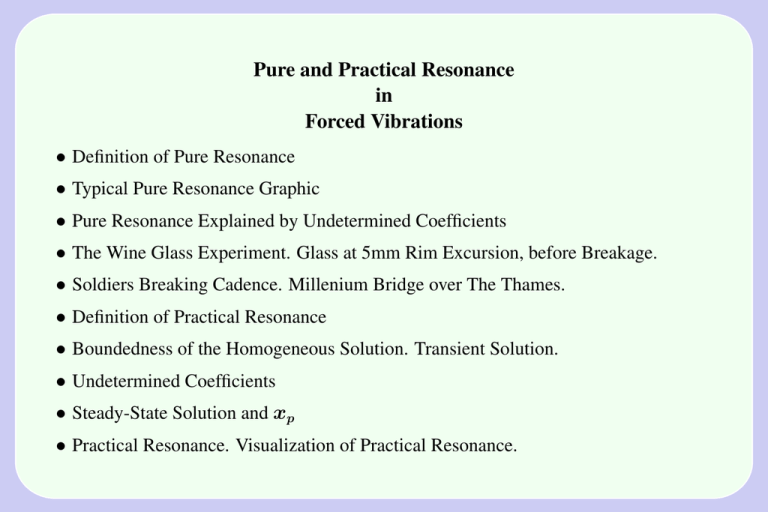
Pure and Practical Resonance in Forced Vibrations • Definition of Pure Resonance • Typical Pure Resonance Graphic • Pure Resonance Explained by Undetermined Coefficients • The Wine Glass Experiment. Glass at 5mm Rim Excursion, before Breakage. • Soldiers Breaking Cadence. Millenium Bridge over The Thames. • Definition of Practical Resonance • Boundedness of the Homogeneous Solution. Transient Solution. • Undetermined Coefficients • Steady-State Solution and xp • Practical Resonance. Visualization of Practical Resonance. Definition of Pure Resonance The notion of pure resonance in the differential equation (1) x00(t) + ω02 x(t) = F0 cos(ωt) is the existence of a solution that is unbounded as t → ∞. We already know that for ω 6= ω0, the general solution of (1) is the sum of two harmonic oscillations, hence it is bounded. Equation (1) for ω = ω0 has by the method of undetermined coefficients the unbounded oscillatory solution x(t) = F0 2ω0 t sin(ω0 t). Pure resonance occurs exactly when the internal natural frequency ω0 matches the external natural frequency ω, in which case all solutions of the differential equation are unbounded. Typical Pure Resonance Graphic In Figure 1, pure resonance is illustrated for x00 (t) + 16x(t) = 8 cos 4t, which is the undamped forced oscillation model x00 (t)+ω02 x(t) = F0 cos(ωt) with ω = ω0 = 4 and F0 = 8. x t Figure 1. Pure resonance. Graphed are the envelope curves x = ±t and the solution x(t) = t sin 4t of the equation x00 (t) + 16x(t) = 8 cos ωt, where ω = 4. Pure Resonance Explained by Undetermined Coefficients An initial trial solution of x00(t) + 16x(t) = 8 cos ωt is x = d1 cos ωt + d2 sin ωt. The homogeneous solution xh = c1 cos 4t + c2 sin 4t considered in the correction rule has duplicate terms exactly when the natural frequencies match: ω = 4. Then the final trial solution is classified as follows. ω 6= 4 =⇒ x(t) = d1 cos ωt + d2 sin ωt is bounded, no resonance, ω = 4 =⇒ x(t) = t(d1 cos ωt + d2 sin ωt) is unbounded, pure resonance. Even before the undetermined coefficients d1 , d2 are evaluated, we can decide that unbounded solutions occur exactly when frequency matching ω = 4 occurs, because of the amplitude factor t. If ω 6= 4, then xp (t) is a pure harmonic oscillation, which implies it is bounded. If ω = 4, then xp (t) equals a time–varying amplitude Ct times a pure harmonic oscillation, hence it is unbounded. The Wine Glass Experiment Equation x00 (t) + ω02 x(t) = F0 cos(ωt) is advertised as the basis for a physics experiment in the Public Television Annenberg CPB Project, called the wine glass experiment. Cal Tech physicist Goodstein, in front of an audience of physics students, equips a lab table with a frequency generator, an amplifier and an audio speaker. The valuable wine glass is replaced by a glass lab beaker. The frequency generator is tuned to the natural frequency of the glass beaker (ω ≈ ω0 ), then the volume knob on the amplifier is suddenly turned up (F0 adjusted larger), whereupon the sound waves emitted from the speaker break the glass beaker. The 29-minute CPB video can be viewed in a browser, no cost. Find it in Resonance #17 at the link below. The wine glass experiment is the last 4 minutes of the film. http://www.free-ed.net/free-ed/Science/Physics/ http://www.learner.org/vod/vod window.html?pid=566 The glass itself will vibrate at a certain frequency, as can be determined experimentally by pinging the glass rim. This vibration operates within elastic limits of the glass and the glass will not break under these circumstances. A physical explanation for the breakage is that an incoming sound wave from the speaker is timed to add to the glass rim excursion. After enough amplitude additions [from 1mm initially to eventually 5mm], the glass rim moves beyond the elastic limit and the glass breaks. The explanation implies that the external frequency from the speaker has to match the natural frequency of the glass. But there is more to it: the glass has some natural damping that nullifies feeble attempts to increase the glass rim amplitude. The physicist uses to great advantage this natural damping to tune the external frequency to the glass. The reason for turning up the volume on the amplifier is to nullify the damping effects of the glass. The amplitude additions then build rapidly as sound wave energy gets stored in the glass, seen as rim vibrations, and the glass breaks. Glass at 5mm Rim Excursion, before Breakage Figure 2. Still image from a wine glass experiment video. The source for the still image is the wine glass experiment Quicktime video found at Blaze Labs, http://www.blazelabs.com/f-p-glass.asp A source for high speed video and more explanation is MIT Physics, http://video.mit.edu/watch/breaking-glass-with-sound-3947/ Soldiers Breaking Cadence The collapse of the Broughton bridge near Manchester, England in 1831 is blamed for the now–standard practise of breaking cadence when soldiers cross a bridge. Angers Bridge (Basse-Chane Bridge), a suspension bridge over the Maine River in Angers, France, collapsed on April 16, 1850, while a battalion of French soldiers was marching across it, killing 223. Bridges like Broughton and Anger (Basse-Chane) may have had many natural low frequencies of vibration, so it is possible for a column of soldiers to vibrate the bridge at a natural frequency of the bridge. The bridge locks onto the frequency while the soldiers continue to append energy with every step, undamped by the bridge, causing increased amplitude in the bridge oscillations. The two bridges in question collapsed for structural reasons, perhaps due to resonance, perhaps not. History has unrevealed secrets. Millenium Bridge over the Thames In 2000, the Millenium Bridge was opened in London, and closed shortly thereafter, due to unusual vibrations caused by the foot traffic. It was re-opened in 2002 after spending an additional 5 million pounds on bridge re-design. Read about the bridge here: http://en.wikipedia.org/wiki/Millennium Bridge (London) Figure 3. London’s Millenium Suspension Footbridge over the Thames. Definition of Practical Resonance The notion of pure resonance is easy to understand both mathematically and physically, because frequency matching characterizes the event. This ideal situation never happens in the physical world, because damping is always present. In the presence of damping c > 0, it will be established below that only bounded solutions exist for the forced springmass system (2) mx00(t) + cx0(t) + kx(t) = F0 cos ωt. Our intuition about resonance seems to vaporize in the presence of damping effects. But not completely. Most would agree that the undamped intuition is correct when the damping effects are nearly zero. Practical resonance is said to occur when the external frequency ω has been tuned to produce the largest possible solution (a more precise definition appears below). It will be shown that this happens for the condition q ω = k/m − c2/(2m2), k/m − c2/(2m2) > 0. (3) p Pure resonance ω = ω0 ≡ k/m is the limiting case obtained by setting the damping constant c to zero in condition (3). This strange but predictable interaction exists between the damping constant c and the size of solutions, relative to the external frequency ω , even though all solutions remain bounded. Boundedness of the Homogeneous Solution The decomposition of x(t) into homogeneous solution xh (t) and particular solution xp(t) gives some intuition into the complex relationship between the input frequency ω and the size of the solution x(t). The homogeneous solution. For positive damping, c > 0, equation (2) has homogeneous solution xh (t) = c1 x1 (t) + c2 x2 (t) where according to the recipe the basis elements x1 and x2 are given in terms of the roots of the characteristic equation mr 2 +cr+k = 0, as classified by the discriminant D = c2 − 4mk, as follows: Case 1, D > 0 Case 2, D = 0 Case 3, D < 0 x1 = er1t, x2 = er2t with r1 and r2 negative. x1 = er1t, x2 = ter1t with r1 negative. x1 = eαt cos βt, x2 = eαt sin βt. Symbols α, β satisfy β > 0 and α = −c/(2m) < 0. It follows that xh (t) contains a negative exponential factor, regardless of the positive values of m, c, k. Then xh (t) is bounded. Transient Solution A solution x(t) is called a transient solution provided it satisfies the relation limt→∞ x(t) = 0. The conclusion: The homogeneous solution xh(t) of the equation mx00(t) + cx0(t) + kx(t) = 0 is a transient solution for all positive values of m, c, k. A transient solution graph x(t) for large t lies atop the axis x = 0, as in Figure 4, because limt→∞ x(t) = 0. Figure 4. Transient oscillatory solution x = 2e−t (cos t + sin t) of the differential equation x00 + 2x0 + 2x = 0. Undetermined Coefficients The method of undetermined coefficientsa applied to mx00 + cx0 + kx = F0 cos ωt gives a trial solution of the form x(t) = A cos ωt + B sin ωt with coefficients A, B satisfying the equations (k − mω 2)A + (cω)B = F0, (−cω)A + (k − mω 2)B = 0. (4) Solving (4) with Cramer’s rule produces the solution (5) a A= (k − mω 2)F0 ∆ , B= cωF0 ∆ , ∆ = (k − mω 2)2 + (cω)2. Rule I applies. Rule II does not apply, because of limt→∞ xh (t) = 0. Steady-State Solution and xp The steady–state solution, periodic of period 2π/ω , is given by xp(t) = (6) F0 ∆ (k − mω 2) cos ωt + (cω) sin ωt F0 xp(t) = √ cos(ωt − α), ∆ ∆ = (k − mω 2)2 + (cω)2, where α is defined by the phase–amplitude relations (7) C cos α = k − mω 2, C sin α = cω, F0 p C= . (k − mω 2)2 + (cω)2 The terminology steady–state refers to that part xss (t) of the solution x(t) that remains when the transient portion is removed, that is, when all terms containing negative exponentials are removed. As a result, for large T , the graphs of x(t) and xss (t) on t ≥ T are the same. This feature of xss (t) allows us to find its graph directly from the graph of x(t). We say that xss (t) is observable, because it is the solution visible in the graph after the transients (negative exponential terms) die out. Practical Resonance Practical resonance is said to occur when the external frequency ω has been tuned to produce the largest possible steady–state amplitude. Mathematically, this happens exactly when the amplitude function C = C(ω) defined in (7) has a maximum. If a maximum exists on 0 < ω < ∞, then C 0 (ω) = 0 at the maximum. The power rule implies 0 C (ω) = (8) −F0 2(k − mω 2)(−2mω) + 2c2ω ((k − mω 2)2 + (cω)2)3/2 C(ω)3 2 2 2 = ω 2mk − c − 2m ω F02 2 2 If 2km − c2 ≤ 0, then C 0 (ω) does not vanish for 0 < ω < ∞ and p hence there is no maximum. If 2km − c > k/m − c2 /(2m2 ) in 0 < ω < ∞ and by 0, then 2km − c2 − 2m2 ω 2 = 0 has exactly one root ω = C(∞) = 0 it follows that C(ω) is a maximum. Practical resonance for mx00(t) + cx0(t) + kx(t) = F0 cos ωt occurs precisely when the external frequency ω is tuned to ω = p k/m − c2/(2m2) and k/m − c2/(2m2) > 0. Visualization of Practical Resonance In Figure 5, the amplitude of the steady–state periodic solution is graphed against the external natural frequency ω , for the differential equation x00 + cx0 + 26x = 10 cos ωt and p damping constants c = 1, 2, 3. The practical resonance condition is ω = 26 − c2/2. As c increases from 1 to 3, the maximum point (ω, C(ω)) satisfies a monotonicity condition: both ω and C(ω) √ decrease √ as c √increases. The maxima for the three curves in the figure √occur at ω = 25.5, 24, 21.5. Pure resonance occurs when c = 0 and ω = 26. C c=1 c=2 c=3 ω Figure 5.pPractical resonance for x00 + cx0 + 26x = 10 cos ωt: amplitude C = 10/ (26 − ω 2)2 + (cω)2 versus external frequency ω for c = 1, 2, 3.

